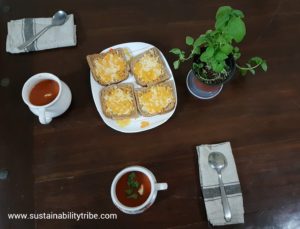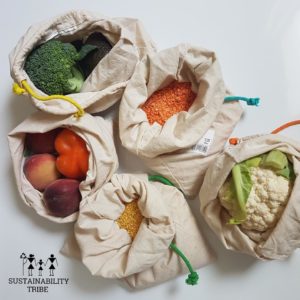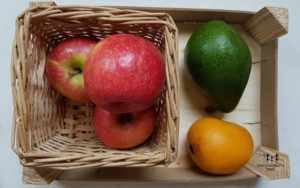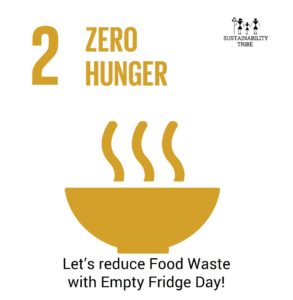Does this sound familiar to you? On a regular supermarket visit, you look at neatly arranged fresh fruits and vegetables on the racks and decide to eat healthy over the next week. You end up buying as many fresh vegetables thinking about all the health benefits of consuming them. Then you see a lot of fresh fruits and you pick the whole crate or bag of pre-packed fresh fruits. Then you go to the baker’s corner or ready to eat section and the smells there are so overpowering that you can’t hold yourself back from picking a few things from there. Then you see ‘two for the price of one pack in a frozen section which you happily toss in your shopping cart calculating how much money you saved there. Finally, after running from aisle to aisle in a supermarket, you come home exhausted and quickly dump your just bought fresh food in the fridge. You feel good that your fridge is all stocked up for the next week now.
But after a few weeks when you dig back of your fridge you find a half-finished steal bread, some fruits at bottom of the crate with mold on it. Wilted greens lying in vegetable drawers. Some overripe bananas or an avocado rotten inside. Obviously, all of it goes to the bin straight away, aren’t we very particular about what we eat!
If any of this happens to you, then here are some statistics that won’t surprise you. 20% of the food we buy is wasted and ends up in the landfill. In the UAE leftover food waste is expected to go up from 2.7 kg per person daily to 4.5 kg during the holy month of Ramadan. Do you know which are the most wasted food items in general? Milk, bread, vegetables, and fruits which almost all of us consume.

Food Waste in the Fridge
Food waste starts right from the source at production then at catering and food processing, supermarkets, and of course at the consumer level. Food waste has a big impact on the environment because when we waste food we also waste resources like water, energy, fuel, etc invested in growing, storing, and transporting the food. Plus the food waste decomposes in a landfill, releases methane gas which is a greenhouse gas and it adds up into creating global warming. A report from the U.K. estimates that if food scraps were removed from landfills then, the level of greenhouse gas abatement would be equivalent to removing one-fifth of all the cars in the country from the road.
But then how do we reduce food waste, at least at our home?
These are the most common guidelines you can find when it comes to reducing food waste at home. Those are great tips and very useful, but not enough. Even after I shop smart and plan my meals I could reduce food waste but not completely. I tried different ways of composting my food scraps, but honestly, composting is not an answer for food waste. It takes a long time to decompose a small portion of organic waste and how much compost do you really need for a small home garden. There needs to be a more efficient solution in reducing food waste. So I figured out a new solution to my problem which not just worked great but added so much fun element to my quest of reducing food waste at home and broke the monotony of planning meals.
Every time we go grocery shopping and shop smart, we don’t really come home to an empty fridge and fill it up with our newly bought fresh items. There are always things lying in the fridge, some are leftovers or some are ingredients which we generally decide to use in the next meals but then we forget about it. Those items mostly get pushed on the back of the fridge and generally end up in a garbage bin.
So I decided to find a permanent solution and started a new tradition in our family, Empty Fridge Day. Like many families, we do our grocery shopping weekly. The day before grocery shopping is Empty Fridge Day. So what I do basically is I make a dinner out of whatever ingredients are left in the fridge. Does it sound like ‘mystery basket ingredients’ on the show Chopped? Actually, it is exactly the same. So I gather whatever perishable items are left in the fridge, use some other essential ingredients and try to make a dinner plate out of it. Honestly, it’s not always a success, won’t say much about it, I am sure my husband has a lot to say about those failed days. But I am getting better at it, I now type all my ingredients in google and type the ‘recipe’ word after it.
Cucumber, chocolate cake, lettuce, milk, tomato, bell pepper, yogurt, coriander, okra, how does that sound? Some of these will be our this week’s Empty Fridge Day ingredients. But I can think of a few recipes from totally different cuisines! This whole idea of empty fridge recipes sounds crazy, right? But actually, I have discovered really cool recipes through it.
Thankfully our family likes to experiment with food, so we eagerly look forward to our Empty Fridge Day as a fun meal and as a challenge! The meal we make on Empty Fridge Day, I call it our weekly Zero Waste Meal, which helps us reducing food waste.
Here is one example of our Empty Fridge Day, a zero-waste meal.
Ingredients in Fridge: Leftover boiled penne pasta, cherry tomatoes, Laban
Essentials: garlic, onion, whole wheat flour, fresh basil from window garden
I googled the recipe and found a very quick & easy one. After adding flour with tomatoes and then buttermilk when tomatoes were cooked. The result was fantastic! This was one of the first Empty Fridge Day, zero-waste meals from last year. Since then Empty Fridge Day is now our weekly ritual, sometimes we manage to empty our fridge before the day arrives thanks to my very smart shopping skills in those weeks. So then we replace our Empty Fridge Day with our old pizza nights.
This is one more Empty Fridge Day meal, table setting included a fresh basil plant inspired by the world’s best tomato soup I had in a farm-to-table restaurant in Iceland.

Tomato soup with fresh basil, garlic bread with cheese out of leftover ingredients
Here are some of my top essential ingredients in the pantry I use on Empty Fridge Days to transform leftovers from the fridge into a decent meal. These ingredients basically can go with most of the perishables ingredients left in the fridge.
Onion & ginger are useful to make Indian curries with pulses or vegetables and can be served with rice or bread.
Now after an empty fridge day, I get a clean slate to stock up my perishables and essential pantry items after every weekly grocery shopping trip. I shop plastic-free and with zero waste so I basically buy my groceries in reusable containers and cotton produce bags. You might think without plastic bags it can be difficult to store food in the fridge but that is not the case. I use airtight glass jars, cloth napkins, and some old plastic breathable boxes to store my vegetables and make them last longer.

Zero waste grocery shopping
My essentials are root vegetables like onion, potato, garlic, ginger, and even most of the fruits I don’t store in the fridge instead I use traditional ways to store them.
Onions, garlic, and ginger can be stored together in one basket, but potatoes need to be separated to avoid sprouting. All of these root vegetables need a cool, dry, and dark place for storage. So I have two dedicated bamboo baskets in my bottom kitchen cabinet.
I prefer to buy unripe tomatoes and store them on the counter, ripening tomatoes smell great and give better flavor. But if I bought ripe tomatoes I store them in the fridge. I prefer to buy fruits a little unripe, not ready to eat if I am buying for the coming week, and let them ripe in my fruit tray on the counter especially bananas, avocado, mango, etc. Make sure you are storing apples separately to avoid over-ripening other fruits. But berries, grapes need to go in the fridge.

Fruit storage on counter
For greens like coriander, spinach, fenugreek leaves, mint I cut the roots and ends, remove dirty leaves, and store them in a plastic box with a breathable opening. For leaves like lettuce, kale better separate leaves from the bunch, clean them and wrap them in a cotton tea towel, and store them in the fridge.
I generally don’t buy herbs and prefer to grow them in my balcony garden so that I have access to fresh herbs when I need them. If you buy a bunch of any herb and use up only a little, you can dry the herbs and store it in a freezer. I also store spices and curry powders in the freezer, so that they can last longer. I don’t really buy much frozen or processed food regularly.
To store leftover cooked food, I use airtight glass containers. But I always try to cook food just enough so that not much food will be left to store in the fridge. Controlling cooking portions is important to reduce food waste. If your family doesn’t want to eat the same preparation, again and again, there is a big probability of wasting that food. Plus it’s healthy to eat freshly prepared food as much as possible. Also, it’s great to include your kids in food buying, preparation, storing so that from early on they get aware of food waste issues. When we tell our kids ’empty your plate, do not waste food it’s bad manners!’, they also need to learn about food waste even before it comes to our plates.
As part of the United Nations’ sustainable goals for 2030, the second sustainable development goal is Zero Hunger. in 2012, United Nations Secretary-General Ban Ki-moon created a zero hunger challenge that can end hunger, eliminate all forms of malnutrition, and build inclusive and sustainable food systems.
One of the important elements of this zero hunger challenge is to Eliminate loss and waste of food. If we follow Empty Fridge Day along with other tips on reducing waste we can eliminate food waste on the consumer side. You can read some key facts about food waste and food loss on the Food and Agricultural Organization. Lastly, you can read our article, ‘How can you help reducing world hunger?‘
Let me know how many of you are starting your Empty Fridge Day at home and how effectively you can avoid food waste through it?

Join ‘Empty Fridge Day’
Remember, 1 in 7 people in the world go to bed hungry, so we all should respect the food to which we have access! Stay tuned for more tips on reducing food waste.

Amruta Kshemkalyani, an expert sustainability professional turned social entrepreneur, is the founder of the Sustainability Tribe, AK Sustainability
Read More >>
Copyright 2025 © Sustainability Tribe, Registered under 'Sustainability Tribe Marketing Management' in the U.A.E., Design by LBM INFOTECH
Thanks for the tips! I try to use as much of our produce as we can.
I am glad you liked the tips Tarana. Try out Empty Fridge Day, it’s fun!